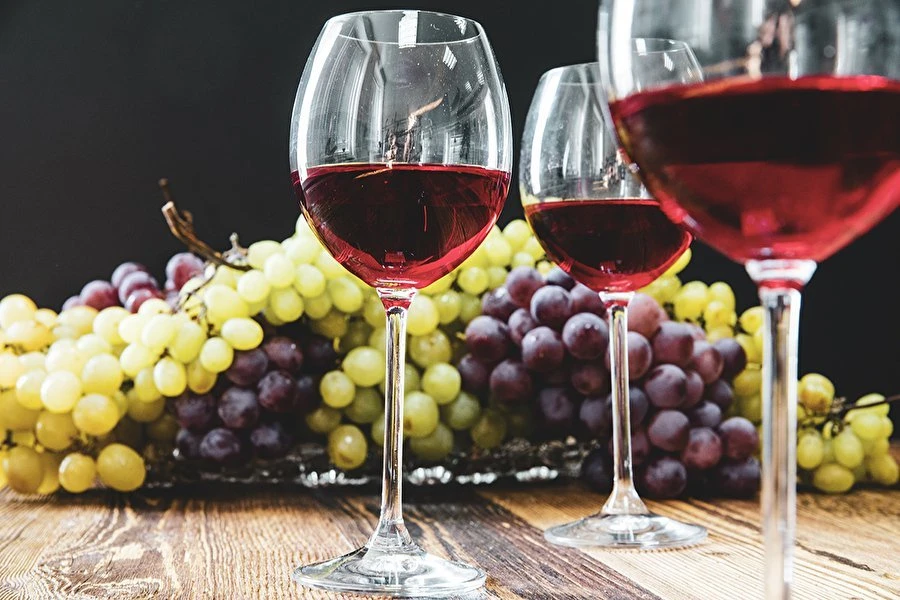Natural tannins are characterised by antioxidative activity that enables extending the best before date of many food products. Red grape wine is an excellent example of that. Thanks to the high content of tannins it cane age for many years, obtaining noble properties gradually and retaining them for a long time.
Tannins are divided into:
- hydrolysable – containing a simple sugar, usually glucose;
- condensed – included among the so-called polymeric flavonoids. They are present the most often in unripe fruit, cereal grains, leguminous vegetables, and oil bearing plants.
Tannins can also be found in food products such as coffee, tea, cocoa, or cheese. They are also present in walnuts.
What impact do the tannins have on wine?
The main effect of tannins on wine is its taste. When tasting a tannin-rich wine, we will be able to discover its tartness and its characteristic slightly bitter aftertaste. That aftertaste can be experienced quite easily. It is slightly different with tartness, which is only a specific feeling appearing in the mouth. It is so because tannin reacts with proteins present in the saliva, which, in turn, leads to experiencing something akin to dryness and roughness in the mouth, something valued very highly among wine connoisseurs. Many people claim that thanks to tannins the wine aging time can be extended significantly. There is a lot of truth to that, although it has to be underlined the tannin content is not the sole criterion of a wine’s potential. In case of production of red wine there can be indicated a number of key elements having impact on the final tannin content:
The most important thing is the grapevine variety – some of them contain more tannins naturally. That group includes: Nebbiolo, Cabernet Sauvignon, Tempranillo, or Petit Verdot.
Another important thing is the process of maceration – storage of grape skins together with grape flesh, seeds, and juice after the destemming stage. The fruit prepared in such a manner release juice that becomes infused with the whole abundance of compounds present in the skins. Those are mainly tannins, but also dyes and aromatic compounds. It is worth remembering that the longer the maceration takes, the more tannins appear in wine.
Another important thing is the method of pressing the fruit remaining after maceration. Excess pressure exerted by the winepress may lead to the grape seeds being crushed and imparting their unpleasant taste resulting from their content of tannins. Grape should be pressed with care, since doing it too strongly may lead to extracting too many tannins from the skins, which has an additional negative impact on wine quality.
In general, it is worth remembering that tannins (in appropriate amount) provide wine with unique taste and constitute a sort of “spine” of the drink, the basis of its quality.
The final stage of wine production – referred to as maturation – has a tremendous impact on the “character” of tannins. The older the wine becomes, the gentler the tannins it contains become. After appropriate wine aging time, they may provide a very desirable feeling of silkiness and full body, resulting in the wine receiving a high grade during tasting.
When preparing a batch, every producer of homemade wine should make sure that his product contains the right dose of tannins – both those providing the wine with excellent aroma and those providing it with a beautiful colour. It is worth taking advantage of offers available on the market – e.g. TanCOLOR or TanAROMA natural tannins. Adding oak chips may also have a positive impact, as they impart a certain portion of tannins to wine as well.
A very interesting matter is the impact of wine tannins on the taste of food. When combining a meal with a tannin-rich wine it is recommended to skip salty and spicy ingredients, since tannins increase the feeling of “burning” in mouth. The wines of this type go best with red meat and underline its flavour. Yellow cheese varieties, e.g. distinctive Parmesan cheese, are also going to be a good choice. When learning the secrets of winemaking and perfecting the production of own homemade wines, the appreciation of the role of tannins is one of the crucial moments. They have a significant impact on the quality of wine obtained and are decisive when it comes to the pleasure from long-awaited tasting. Therefore, let us not be afraid of tannins, but rather use their values wisely and enjoy the effect they help obtain when working together with winemaking yeast, dedicated nutrients, and other extras that our wine would enjoy receiving...







 Cheese calculator
Cheese calculator



 Winemaking
Winemaking










